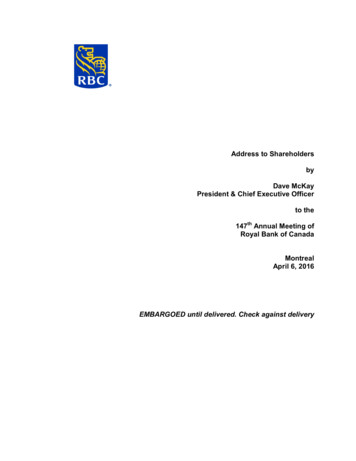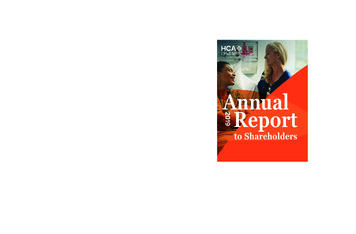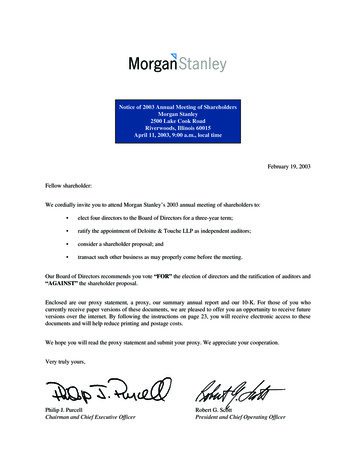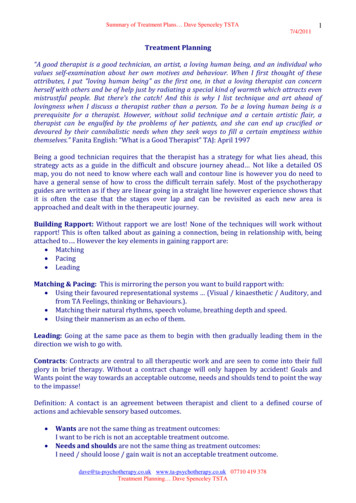
Transcription
Address to ShareholdersbyDave McKayPresident & Chief Executive Officerto the147th Annual Meeting ofRoyal Bank of CanadaMontrealApril 6, 2016EMBARGOED until delivered. Check against delivery
DISCLAIMERThe following speakers’ notes and the webcast have been furnished for your information only, are current only as ofthe date of the webcast, and may be superseded by more current information. Except as required by law, we do notundertake any obligation to update the information in these speakers’ notes, whether as a result of new information,future events or otherwise.These speakers’ notes are not a transcript of the webcast and may not be identical to the comments made during thewebcast. You can replay the entire webcast up to April 2017 by visiting the Royal Bank of Canada (“we” or “our”)website at g-reports.html.In no way do we assume any responsibility for any investment or other decisions made based upon the informationprovided on our website or in these speakers’ notes. Users are advised to review the webcast itself and our filingswith the Canadian Securities Regulators and the United States Securities and Exchange Commission (“SEC”) beforemaking any investment or other decisions.CAUTION REGARDING FORWARD-LOOKING STATEMENTSFrom time to time, we make written or oral forward-looking statements within the meaning of certain securities laws,including the “safe harbour” provisions of the United States Private Securities Litigation Reform Act of 1995 and anyapplicable Canadian securities legislation. We may make forward-looking statements in these Annual Meeting ofCommon Shareholders speakers’ notes, in filings with Canadian regulators or United States (U.S.) Securities andExchange Commission (SEC), in reports to shareholders and in other communications. Forward-looking statementsin this speech include, but are not limited to, statements relating to our financial performance objectives, vision andstrategic goals, the economic outlook, and the outlook for each of our business segments. The forward-lookinginformation contained in these speakers’ notes is presented for the purpose of assisting the holders of our securitiesand financial analysts in understanding our financial position and results of operations as at and for the periods endedon the dates presented and our financial performance objectives, vision and strategic goals, and may not beappropriate for other purposes. Forward-looking statements are typically identified by words such as “believe”,“expect”, “foresee”, “forecast”, “anticipate”, “intend”, “estimate”, “goal”, “plan” and “project” and similar expressions offuture or conditional verbs such as “will”, “may”, “should”, “could” or “would”.By their very nature, forward-looking statements require us to make assumptions and are subject to inherent risksand uncertainties, which give rise to the possibility that our predictions, forecasts, projections, expectations orconclusions will not prove to be accurate, that our assumptions may not be correct and that our financial performanceobjectives, vision and strategic goals will not be achieved. We caution readers not to place undue reliance on thesestatements as a number of risk factors could cause our actual results to differ materially from the expectationsexpressed in such forward-looking statements. These factors – many of which are beyond our control and the effectsof which can be difficult to predict – include: credit, market, liquidity and funding, insurance, operational, regulatorycompliance, strategic, reputation, legal and regulatory environment, competitive and systemic risks and other risksdiscussed in the Risk management and Overview of other risks sections of our 2015 Annual Report and the Riskmanagement section of our Q1 2016 Report to Shareholders; weak oil and gas prices; the high levels of Canadianhousehold debt; exposure to more volatile sectors, such as lending related to commercial real estate and leveragedfinancing; cybersecurity; anti-money laundering; the business and economic conditions in Canada, the U.S. andcertain other countries in which we operate; the effects of changes in government fiscal, monetary and other policies;tax risk and transparency; and environmental risk.We caution that the foregoing list of risk factors is not exhaustive and other factors could also adversely affect ourresults. When relying on our forward-looking statements to make decisions with respect to us, investors and othersshould carefully consider the foregoing factors and other uncertainties and potential events. Material economicassumptions underlying the forward-looking statements contained in these speakers’ notes are set out in theOverview and outlook section and for each business segment under the heading Outlook and priorities in our 2015Annual Report, as updated by the Overview and outlook section of our Q1 2016 Report to Shareholders. Except asrequired by law, we do not undertake to update any forward-looking statement, whether written or oral, that may bemade from time to time by us or on our behalf.Additional information about these and other factors can be found in the Risk management and Overview of otherrisks sections of our 2015 Annual Report and the Risk management section of our Q1 2016 Report to Shareholders.Information contained in or otherwise accessible through the websites mentioned does not form part of thesespeakers’ notes. All references in these speakers’ notes to websites are inactive textual references and are for yourinformation only.
Thank you Katie.Welcome to our 147th Annual General Meeting.We are pleased to be back in Montreal for our AGM.It’s a bit of a homecoming for me, as I was born and grew up in this city, and still havefamily here.In fact, my first encounter with a bank took place in Ville Saint Michel, when my father, asmall business owner, took me to his local Royal Bank branch to show me a thing ortwo about managing money.I still can picture the manager coming out from his office to serve us, as we werestanding in line. He said he hated to see clients wait.For me, it was an early lesson in the Royal treatment.While a lot has changed since then, some things haven’t.Client service is still at the heart of RBC. Doing what’s right still matters, perhaps morethan ever. And being part of our communities continues to drive us.It’s our purpose. And purpose can never be disrupted.Every time I return to Montreal, I’m impressed with the city’s social and economicprogress.Montreal has transformed its economy since the 1980s, and is now a leader in manyknowledge sectors — from aviation to medical science, to computer animation andgaming.If there’s one thing behind this progress, it’s the Province of Quebec’s investment inpeople — in education, in child care and in finding ways to positively engage the entirepopulation in the economy.Diversity and inclusion are driving Quebec’s and Canada’s prosperity.They’re fundamental to RBC’s success, too.Last year, I presented our strategy to you, with a focus on three pillars:o first, to continue to grow as the undisputed financial services leader in Canada;o second, to expand in the U.S. as our second home market;o and third, to increase our reach in selected markets internationally.1
I’m pleased to say that because of this strategy, in 2015 we were the first Canadiancompany ever to earn 10 billion in a fiscal year. That was up 11% from 2014, reflectingrecord earnings in Canadian Banking, Capital Markets, and Investor & TreasuryServices.As you can see on the slide, our employees met all of our financial performanceobjectives.o We grew earnings per share by 12%o We delivered a return on equity of 18.6%o We increased our quarterly dividend twice during the year, and again in Q1o We closed the year with a very strong CET1 ratio of 10.6%We remain committed to these same objectives going forward.And in the first quarter of 2016, in a challenging operating environment, we continued todeliver solid earnings of 2.4 billion.Naturally, there have been concerns about the impact of low oil prices on our business,which I’d like to address.Oil and gas represents about 1.6% of our total loan book and our provision for creditloss remains in line with historic norms.We also believe the significant gains that oil markets have made since January will hold,given that the US economy continues to grow, albeit slowly.Here in Canada, the lower dollar has done its job, with exports and investments now onthe rise.With this context in mind, I’d like to take you through our various businesses anddescribe some of their strategic progress.Our Canadian banking franchise remains the cornerstone of RBC.We’re #1 or #2 in every major business segment, and continued in 2015 to grow ourmarket share in key categories.We have the most diversified customer base among banks in Canada, the country’sstrongest brand, and employee engagement levels that are among the best in the world.Our customers continue to recognize this, and our net promoter score has grown inevery year but one since 2004.2
In fact, our score is now double what it was in the early 2000s, and explains why RBC isthe #1 bank when it comes to cross-selling and offering a wide range of products tomeet our clients’ complex financial needs.For these reasons and more, we were named by Retail Banker International magazineas Retail Bank of the Year for the second year in a row -- an honour no other Canadianbank has ever achieved.We recognize that the world of finance and banking is changing. What made ussuccessful in the past will not guarantee our success in the future.We see this evolution as an opportunity – an opportunity to grow as a digitally-enabledrelationship bank.We’re now seeing 60% of all financial transactions, excluding cash withdrawals, comingthrough digital and mobile channels.Last year, to better serve that demand, we launched an industry-leading, mobile wallet.This year, we’ve revamped our iPhone and Android mobile banking experience and willbe bringing new functionality into our Mobile Wallet.We’ve already seen more than 5 million downloads of our mobile banking app.In this increasingly instant and digital world, consumers don’t plan their finances likethey once did, which means we need to know our customers’ needs, their wants, theirambitions, and their fears, often without ever asking them directly.We need to place ourselves in the context of their lives.In short, we need to think of ourselves as their financial Siri.So what are RBC’s advantages?o First, scale. With more than 14 million clients in Canada, we have the resourcesand market knowledge to build, test and improve on ideas that make our clients’financial lives better — and attract premium partners.We’ve done just that with our Avion credit card, by forging innovativepartnerships with the brands and services that our clients love, including TheRunning Room, airbnb, Saks Canada and Apple.o Second, reciprocity. We have critical mass to help our customers lever theirpurchasing power, by giving them more reward points, better prices and morepremium services than our competitors.o And third, data. Our client base gives us better insights on how they buy, borrow,invest and trade — insights that help us to anticipate client needs.3
We’re approaching these opportunities in very new ways for a bank. For the past twoyears we’ve relied on dynamic, agile teams to build products and adjust them —according to customer preferences.In the process, we have found our time to market is much faster. Our employees aremore engaged. And our costs are lower.It’s one of the reasons we’re ranked as the most cost-efficient bank in Canada, with anefficiency ratio of 53%. It’s this efficiency that allows us to re-invest in exceptional clientexperiences.This is our DNA.Our strength in core banking continues to benefit other parts of our business, notablyWealth Management.RBC already is Canada’s top asset manager and operates the largest network ofadvisors, and our reach among high net-worth clients is expanding.Over the past five years, our Canadian Wealth business increased its share of the highnet worth market by about 500 basis points — to 20%. We expect that to grow.The synergies between our top retail platform and wealth business are significant, frommutual funds sold in branches to referrals of our commercial banking customers toadvisers.It’s this combination of premium businesses — banking and wealth management — thatwill continue to drive premium performance.In the U.S., we’ve doubled our private client business since 2010 and are now the 7thlargest full-service brokerage house by assets under administration.The acquisition of City National Bank, a highly regarded private and commercial bank,was the largest strategic move in our history and positions us well for growth in some ofthe most dynamic U.S. centres.Since buying City National, we continue to hear from Americans who want to takeadvantage of RBC’s global reach and expertise, our range of financial products, ourstrong balance sheet — and our reputation as a principled organization.We have an exciting future ahead. And we’re off to a great start with City National,which generated more than 100 million of additional earnings in its first quarter. Acrossthe U.S. last year, we generated 1 billion of earnings, and we believe we can doublethat.While investing for the future, we have also made significant progress in exitingbusinesses that we don’t feel will be long-term contributors to shareholder value.4
We sold our Swiss private banking business and announced the sale of both ourCaribbean wealth management operation, and our Canadian home and auto insurancebusiness.This emphasis on actively managing our portfolio, with a sharp focus on strategy andexecution, is already producing dividends.A good example of this was our Caribbean banking segment, which has deliveredstrong results for the past several quarters, an impressive turnaround for a businessthat was losing money until two years ago.In Capital Markets, we maintained our leading position in Canada, and were namedCanada’s “Best Investment Bank” for the 8th straight year. Our team led the leaguetables in equity, debt and M&A work, supported by an equity research team that’s beenranked number one by Brendan Wood International for 6 years running.In the U.S., the Capital Markets group has doubled its market share in seven years, andnow counts as clients, some 289 of the Fortune 500 companies.In London, we recently signed an agreement to relocate to a new building in 2020,underscoring our commitment to Europe. And we have expanded our presence inFrance and Germany.What you don’t see in these numbers is the culture of our Capital Markets business. Itcontinues to set a standard both at home and abroad.If you’ve read Michael Lewis’s best-selling book Flash Boys, in which RBC played acentral and very positive role, you’re among the millions who now appreciate howFinancial Services can and should be a force for good.Our growing Investor & Treasury Services business is also making a mark. Not only didit deliver record results, it was also rated by our clients as the number one globalcustodian for the 5th consecutive year.One of the reasons our I&TS business has become a global leader is its focus oninnovation.It does this in partnership with clients rather than in isolation.At our innovation lab in Luxembourg, there are currently four client firms at work withour own employees, building new products and platforms, to address real marketneeds.This collaborative approach is core to all innovation at RBC. Our strategy is designed toput some of our best people together with some of our best partners to tackle some ofthe most interesting opportunities in financial technology.5
We have already built innovation labs in Toronto, London, Luxembourg, New York, andOrlando, where our work last year produced three commercial patents, and we’ll soonopen a lab in Silicon Valley and another in the Toronto region.We’ve seeded this effort with 100 million of capital to invest in FinTech venture funds,and directly with start-ups. This will give us a window on emerging trends and an earlyopportunity to work with new technologies.We’re also putting ourselves closer to leading universities, to partner with the best,brightest and boldest minds that we can find.We have supported innovation programs on campuses across the country. Yesterday,we announced a 3-million, ground-breaking initiative with the University of Toronto, tobuild a start-up accelerator for student and graduate entrepreneurs to developcommercial ideas that will contribute to Canada.In addition to our own innovation work, we’re seeking to inform a national conversationabout the state of innovative thinking in our colleges and universities -- because that’swhat will help shape Canada for decades to come.Collectively, we need to better integrate the classroom and the workplace, if we’re tocreate the companies and campuses of the future.Through the Business Council of Canada, I’m leading a group of corporate CEOs anduniversity and college presidents to explore ways to supercharge this approach toeducation, employment and entrepreneurship.Canadian colleges and universities have come a long way since I was a co-op studentin the 1980s. Nearly half of post-secondary students now graduate with some form ofwork-integrated learning — whether it be co-ops, internships, apprenticeships or fieldplacements.We need to ensure a majority of college and university students enjoy some level ofwork-integrated learning during their undergraduate years.The recent federal budget took a welcome step with a commitment of 73 million, overfour years, to help universities, colleges and employers create a virtual superhighwayfor students to move back and forth between campuses and workplaces.It’s now time for employers and educators to also fully recognize the value of studentplacements -- for their own benefit as well as for Canada’s next generation.At RBC we’re trying to do our part and more. This year, we’ll hire 750 students inCanada to work on technology projects. A small number of them will be given additionalchallenges in a new program called Amplify, to take on special projects that we think willlead to new businesses for RBC or for the students, or even better, for both.6
In addition, we expect those students to challenge the way we do things, and to “up theeducation game” when they return to the classroom. We want their disruption.That’s the value of work-integrated learning.As a society, we must always strive to ensure future generations have what they needto both thrive and prosper.Whether it’s our pledge to commit 1% of our earnings to important causes -- more than 100 million last year – or the millions of volunteer hours our employees commit, wetake our communities and their challenges very seriously.We also draw inspiration from so many of the people we’re privileged to support,especially our Olympians. We’re honoured to have four of Quebec’s finest with ustoday. I invite you to meet with them out in the foyer after the meeting and share in theirstories, as I have.This common concern is fundamental to our purpose.More and more, we see purpose-driven organizations succeed where so many othersstruggle.Purpose-driven organizations attract the best and most dedicated employees. Theyappeal to the most valuable clients. They inspire better ideas. And in troubled waters,they provide a North Star.In 2015, we invited employees to articulate their views about our purpose. It was anunprecedented company-wide conversation that led to, what we call, CollectiveAmbition.This drive for purpose – which has since been documented by the Harvard BusinessReview – put a simple question to RBCers: “What will future success require -- from allof us?”Over three days, some 20,000 employees joined a global, online, real-time exchange todiscuss what makes a bank great.As one of the active participants, I learned a lot.I learned that RBCers are optimists. Despite all the challenges around us, we see thefuture with an open mind, and with a view that it can be — and should be — better.I learned our employees also want to be part of something bigger. We believe RBC canhelp our clients build that future, for themselves, their families, their companies and theircommunities.7
We came to see our purpose quite simply: to help our clients thrive and theircommunities prosper. It’s why our employees come to work every day. And we think it’swhy clients the world over continue to trust RBC.They know we put clients first. We innovate on their behalf. We collaborate within andoutside RBC – to set new standards. We hold each other to account. And we strive fordiversity —diversity and inclusion — in all that we do.It’s the RBC Way.Ladies and gentlemen, we see this Collective Ambition tested anew almost every day,by a world that is volatile and increasingly distrustful.In the face of such change, many people -- unfortunately -- want to close their doors, toprotect what they have.And yet history shows us that isolation only erodes what we have.We need a society that welcomes us all regardless of origin, gender, physical needs,sexual orientation, or faith. It’s good for society, it’s good for business.Consider a recent study of American start-ups that have reached 1 billion in value, thekind popularly known in Silicon Valley as Unicorns. Of 87 such firms, just over half — 44— have at least one immigrant founder. And in nearly three-quarters of the firms,newcomers hold key management roles.Silicon Valley knows what the city of Florence knew in the Renaissance and whatMontreal is showing us today. Diverse groups make better decisions. They tend to takemore chances. They build resilience in all that they do. And they look outward.Quebec premier Philippe Couillard said it well a few weeks ago, in a speech here in thiscity: “La diversité, c’est l’ouverture sur le monde.” (“Diversity is the gateway to theworld.”)In the years ahead, embracing difference will be the difference — between prosperoussocieties and stagnant ones, between households that thrive and those that struggle,between companies that shape the future and those that remain defined by the past.We believe these values are fundamental to the record results we achieved over thepast year. They’re also at the root of all that we’re excited to take on.It’s why we believe our vision and values separate us from other companies. Theyattract and retain the best talent in banking, they give our long-term shareholdersconfidence, and they draw outstanding clients from around the world to RBC.Like that manager I met as a child in the Ville Saint Michel branch, we are here to servethose clients.8
Thank you for giving us that opportunity.Now, I will turn the meeting back to Katie.9
Overview and outlook section and for each business segment under the heading Outlook and priorities in our 2015 Annual Report, as updated by the Overview and outlook section of our Q1 2016 Report to Shareholders. Except as required by law, we do not undertake to update any forward-looking statement, whether written or oral, that may be










